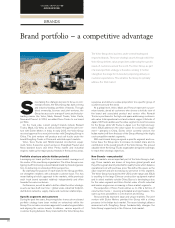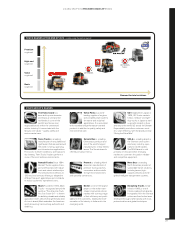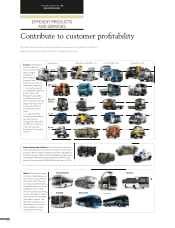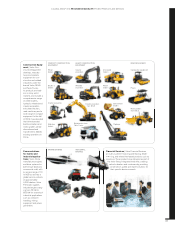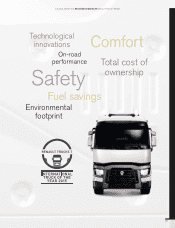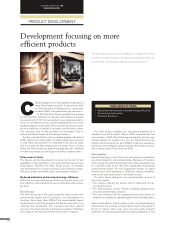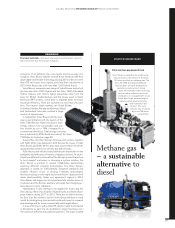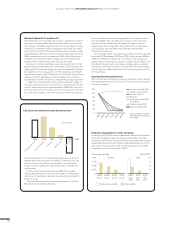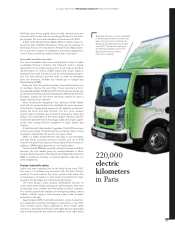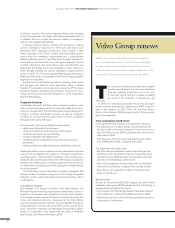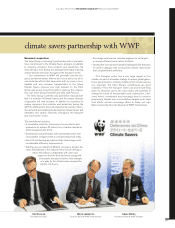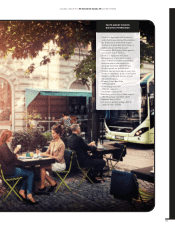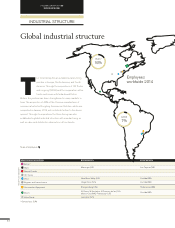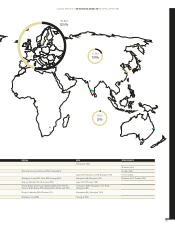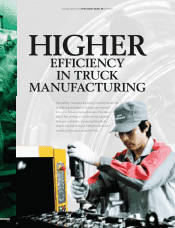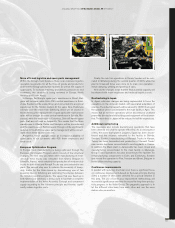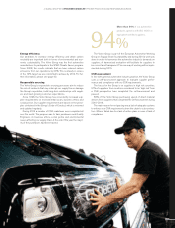Volvo 2014 Annual Report Download - page 44
Download and view the complete annual report
Please find page 44 of the 2014 Volvo annual report below. You can navigate through the pages in the report by either clicking on the pages listed below, or by using the keyword search tool below to find specific information within the annual report.
WWF is one of the world’s largest and most respected
environmental organizations. Its Climate Savers Program
involves multinational companies in the effort to reduce
carbon dioxide emissions. Each company pledges to reduce
its emissions following an agreement made with WWF.
The results are reviewed by independent experts
and the agreed target must be more ambitious
than the company would have set on its own.
Itmust also signify that the company is leading
its sector in the reduction of greenhouse gas
emissions.
In 2010, the Volvo Group became the world’s fi rst auto-
motive industry manufacturer approved by WWF to partici-
pate in the program. In 2012, Volvo CE and Volvo Buses
joined. Volvo Group’s SDLG became the fi rst Chinese com-
pany to be approved.
First commitment 2009–2014
In the agreement Volvo Group is committed to reducing:
• the total amount of carbon dioxide (CO2) emitted by the
Group’s trucks, construction equipment and buses by more
than 30 million tons by 2014, compared with vehicles man-
ufactured in 2008
• CO2 emissions from our production plants by 0.2 million
tons (12%) before 2014, compared with 2008.
Our agreement also states that:
• the Volvo Group will develop a new truck prototype with
20% lower fuel consumption than a corresponding truck
manufactured in 2008 and offer commercial trucks that
operate on renewable gas before 2014
• Volvo CE will prepare a new prototype with considerably
improved fuel effi ciency compared with existing models
• Volvo Buses will expand the number of fi eld tests with
plug-in hybrid buses.
Interim results
Results for the period 2009-2013 (fi gures for 2014 will be
available in late spring 2015) indicate that the Volvo Group is
already ahead of target in key areas:
• CO2 emissions from the Group’s facilities have been reduced
by 0.4 million tons, making them 20% lower than in 2008
• total lifetime emissions of the Group’s products have been
reduced by 40 million tons.
Volvo Group renews
assistance systems that detect impaired driving and emerging
crash risk and provides the driver with timely and relevant alerts. If
a situation still turns critical, the vehicles stability or emergency
systems will engage automatically.
In Europe forward collision warning with emergency braking
will be a mandatory requirement in new trucks and buses as of
November 2015, marking a tremendous step forward in road
safety in Europe. Volvo Trucks' system, which has higher perfor-
mance than the mandatory requirements and a sophisticated
Head-Up-Display system to alert the driver, became standard on
two and three axle Volvo FH in several regions already in the fall
of 2014. During the year, Volvo Buses also presented the new
auto brake technology to become available on Volvo coaches in
2015, already meeting the stricter mandatory requirements to
come in 2018. The Forward Collision Warning and Emergency
Braking functionality is an example of the Volvo Group’s proactive
approach to road safety.
Another event in the safety area was the opening of the world’s
fi rst full-scale test track for active automotive safety in Borås,
Sweden. The AstaZero proving ground is owned by SP Technical
Research Institute of Sweden and Chalmers University of Tech-
nology and has been built and developed in close cooperation
with the Volvo Group.
Transport Solutions
Sustainable transport solutions solve customer problems, opti-
mize customer operations and at the same time, take the environ-
ment into consideration. The Volvo Group develops enabling tech-
nologies, customer and dealer services, as well as integrated
solutions to increase revenue and reduce costs for customers
throughout the product lifecycle.
Customer and vehicle productivity are impacted by;
• uptime and aftermarket technologies
• connected vehicle and infrastructure technologies
• customer and dealer service offerings
• solution integration and deployment
• complete vehicle combinations, including superstructures
and trailers
• vehicle architecture balancing various stakeholder interests.
Challenges relate to how complete vehicle combinations and load
carriers can be adapted with respect to transport assignments,
operating cycles, road and traffi c conditions, maneuvering at ter-
minals etc. By connecting the vehicle to other road users, logistics
providers, the infrastructure, workshops and customer processes,
we will be able to optimize productivity during the complete lifecy-
cle of the product.
The Volvo Group is presently active in a variety of programs that
address different problems using smart technology, integrated
transport systems, advanced engineering, and pioneering vehicle
combinations.
City Mobility Program
One example of a transport solution is the Volvo Group’s City
Mobility Program that brings together key stakeholders in cities to
implement sustainable and integrated innovative pilot projects.
The program includes new technologies for improving energy effi -
ciency and reducing emissions, developed by the Volvo Group,
such as hybrid and electric vehicles. The City Mobility Program is
being deployed in several cities around the world, such as Göte-
borg, Stockholm, Hamburg and Montréal. During 2014, agree-
ments on cooperation were signed with the cities of Shanghai
and Curitiba, with Mexico following in 2015.
40
A GLOBAL GROUP 2014 BUSINESS MODEL PRODUCT DEVELOPMENT


